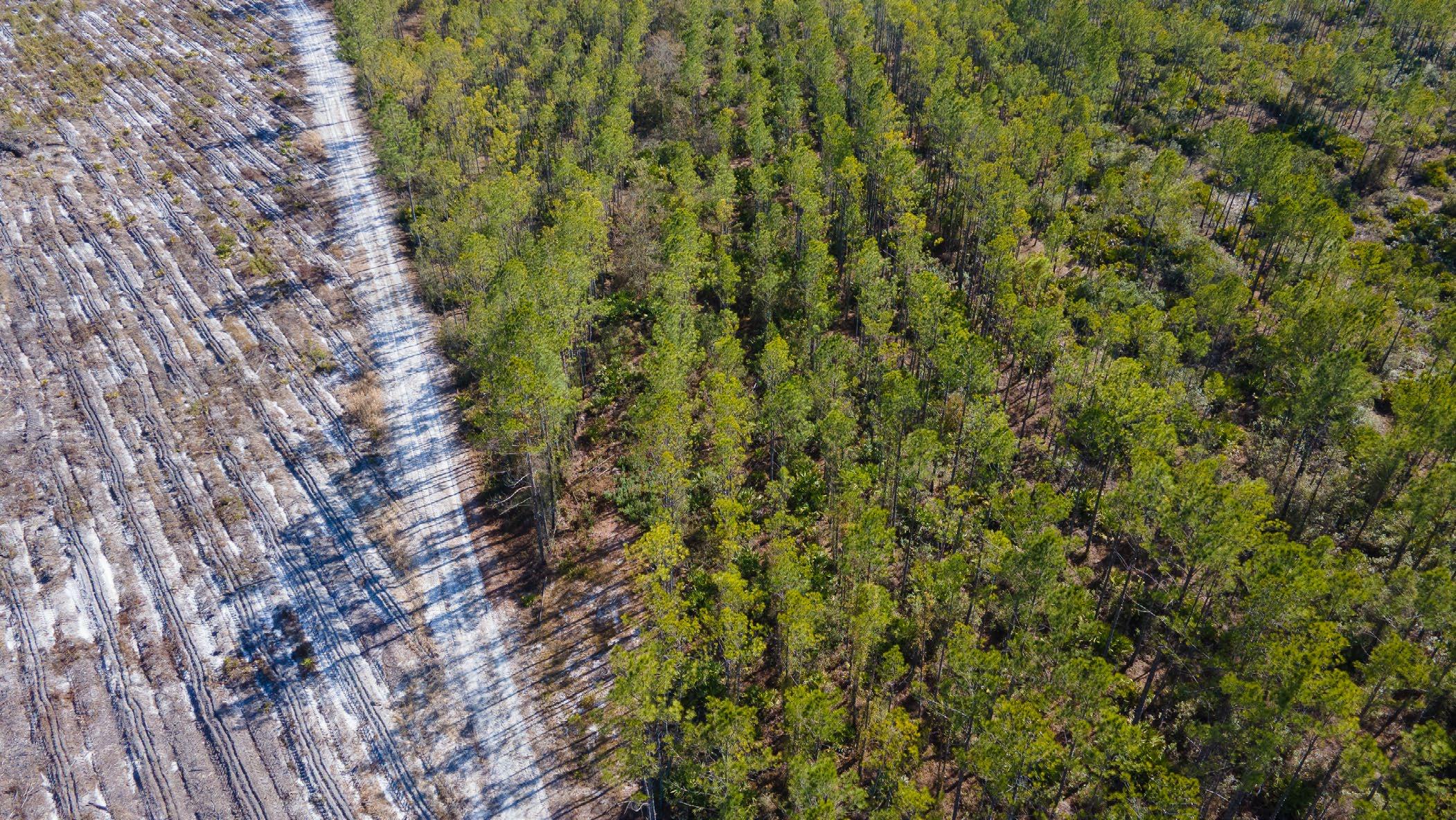
30 minute read
Climate
45%
of emissions could be addressed through the circular economy (Ellen MacArthur Foundation)
Advertisement
¾
of the world’s life on land can be found in the forest (WWF)
700
million people could be displaced by intense water scarcity by 2030 (UN Water)
In this section
Driving carbon reduction
Reaching Net Zero by 2050
Measuring and improving biodiversity
Managing water responsibly
Sending zero waste to landfill
Driving carbon reduction

H OW DOES THIS ENABLE THE CIRCULAR ECONOMY ? The circular economy reduces greenhouse gas emissions through increased resource efficiency and by promoting circular use of fuels and energy. By limiting the production of materials that go to waste, emissions can be cut at source, slowing down the effects of climate change.
Why does this matter?
Driving carbon reduction is crucial to reduce the effects of climate change, which has significant impacts on natural ecosystems, air quality and human health.
How does this contribute to the UN SDGs?
Driving carbon reduction strengthens capacity on climate change mitigation, adaptation and impact reduction. Now
• Set a science-based target of at least 40 per cent per tonne of production by 2030 compared to 20191 • Reduce Scope 1, 2 and 3 GHG emissions 46 per cent by 2030 compared to 20192 • Engage with 100 per cent of our strategic suppliers to encourage them to adopt science-based targets by 20273 • Maintain 100 per cent of our energy consumption is ISO 50001 certified
1. ’Old’ carbon reduction target for the reporting period. 2. ’New’ 1.5°C science-based target, set during the reporting period.
As this is an ’absolute’ reduction target, from next year we will begin reporting progress in ’absolute’ tonnes of CO2e, across all three scopes. 3. Strategic suppliers account for c. 76 per cent of Purchased Goods and
Services Scope 3 emissions in the 2019/20 base year. Next
• Reach Net Zero GHG emissions by 2050
Next steps
• Deliver near-term decarbonisation projects to begin making further progress towards emissions reduction • Undertake our strategic analysis of decarbonisation opportunities in our Packaging plants • Continue to drive our energy efficiency programme by maintaining ISO 50001:2018 certification GHG emissions per tonne of production (kg CO2e/t nsp)
2021/22 2020/21 2019/20 194 205 213
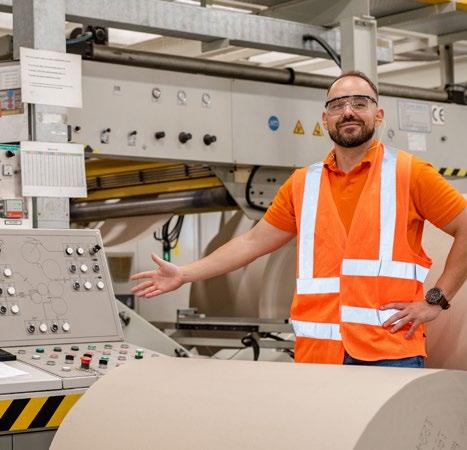
Greening our logistics
We estimate that around 6 per cent of our emissions arise from the transportation of goods in both our own operations and in our supply chain. In our green logistics programme, which is part of our new logistics transformation programme, we are focused on three main areas: • increasing truck-fill • optimising mileage • reducing GHG emissions. We have innovative pilot schemes and programmes in place to green our logistics. For example, we have switched to lower-carbon transportation fuel sources covering journeys in certain regions and we are piloting alternative fuels and electric trucks in other regions. A greener recycling solution for Zurich We are collecting around 8,000 tonnes of used paper and cardboard for recycling annually from Switzerland to our Aschaffenburg Mill in Germany using vehicles powered by LNG (Liquefied Natural Gas). This lower carbon fuel results in c. 8 per cent lesser GHG emissions compared to diesel trucks, removing c. 8,700 tonnes CO2e from our value chain GHG emissions. Although a variety of transportation options were considered for this recycling contract, from rail to electric, LNG proved to be the best solution due to a number of reasons, including cost and environmental benefits. As well as reducing emissions, LNG requires less storage space. For the city of Zurich, one of the most sustainable cities in the world, this solution supports its clear path to a more sustainable future, including its commitment to increase recycling rates and improve air quality.
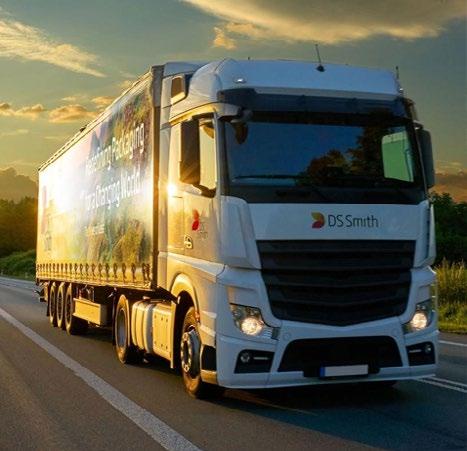
Whilst we undertook the strategic assessment to define our science-based target, we continued to deliver progress in emissions intensity reduction throughout 2021/22, with a Group GHG emissions per tonne of production of 194kg CO2e per tonne of net-saleable production (2020/21: 205kg CO2e/t nsp), a reduction of 5 per cent compared to last year and 9 per cent compared to the 2019/20 base year. This builds on the progress made since the 2015 base year of our previous carbon reduction target, with emissions reduced by 29 per cent per tonne of production over the past seven years. As we have now completed the process with the Science Based Targets initiative to validate our 1.5°C science-based target, our new target is to reduce Scope 1, 2 and 3 GHG emissions 46 per cent by 2030 compared to 2019 and to reach Net Zero GHG emissions by 2050. We will begin reporting progress against this new target in 2022/23. Carbon reduction projects at our paper mills Given that over 80 per cent of our Scope 1 and 2 GHG emissions arise from our Paper operations, our investments in carbon reduction projects have predominantly focused on our greatest emissions assets, which benefit our Packaging customers as reductions in the carbon footprint of paper feed into the packaging lifecycle. During the year, the K4 Combined Heat and Power (CHP) plant at Kemsley Mill began delivering steam and electricity to the mill with a c. 7 per cent efficiency improvement compared to its predecessor, decreasing emissions compared to the retired CHP it replaces. Further steam supply to the mill is met by the K3 waste-to-energy plant, delivering a c. 30,000 tonnes CO2e saving compared to the natural gas-powered solution it replaces. At ContoireHamel Mill, the biogas from the anaerobic waste water treatment plant began delivery, removing c. 1,300 tonnes CO2e. Our €7.5 million expansion of the anaerobic waste water treatment facility at Rouen Mill has boosted biogas production to deliver green electricity with an expected c. 2,600 tonnes CO2e saving annually. At Alcolea Mill, stationary steam siphons are beginning to deliver thermal improvements of around 10 per cent and the vacuum system upgrade at Kemsley Mill is expected to save c. 4,800 tonnes CO2e annually. Projects to increase energy efficiency through measures such as equipment upgrades were implemented at Dueñas Mill, Lucca Mill and Viana Mill during the year. A power agreement (PPA) was introduced to cover a portion of electrical energy demand in Iberia, introducing renewable electricity to our three paper mills, 23 packaging plants and six recycling depots in the region, removing c. 17,000 tonnes CO2e annually.
Carbon reduction projects at our packaging plants At our Packaging plants, we continued to progress plans for wind and solar power opportunities and electric vehicle charging stations. Our Group-wide LED lighting rollout continued, with almost 38,000 lamps installed at 101 sites, delivering c. 14,000 tonnes CO2e savings per annum.
CDP Climate Change In 2021/22, we improved our CDP Climate Change score from B to A-, which is a ‘Leadership’ score, demonstrating best practices associated with environmental leadership, such as setting ambitious and meaningful targets. Maintain that 100 per cent of our energy consumption is ISO 50001 certified
We maintained ISO 50001:2018 at 100 per cent of our in-scope sites, a standard maintained since achieving this target in 2019/20, which drives our Group-wide energy management programme. In 2021/22, our Riceboro Mill was our first site in North America to obtain ISO energy management certification as they became incorporated into our Group-wide energy management system this year, improving how we share best practice across our European and North American businesses. Alcolea Mill and Dueñas Mill also completed their certification during the year.
Information and policies
Group Carbon and Energy Efficiency Policy Group Energy Management Policy CDP Climate Change response
Reaching Net Zero by 2050
Sources of greenhouse gas emissions in 2019/20
Things we buy
Emissions from producing goods and services we buy c. 2.6 million tonnes CO2e
Beginning our journey to Net Zero
Over the past year, we delivered the second phase of our ‘Carbon Project’, which involved engaging expert consultants to develop a series of ‘Net Zero Factory’ concepts. This involved modelling growth and investment phasing over 30 years to tackle our greatest emission sources, including detailed analysis on factors such as local biofuel availability, space availability on site and local regulation, permitting and authorisation. The result of this second phase of our Carbon Project informed our decision to commit to a 1.5°C-aligned science-based target, consistent with the ambition required to limit global warming to 1.5°C above pre-industrial levels. This supports the most ambitious goal of the Paris Agreement. For the remainder of the business, including packaging plants and recycling depots, a ‘top down’ assessment was undertaken and for 2022/23, a more detailed analysis is underway.
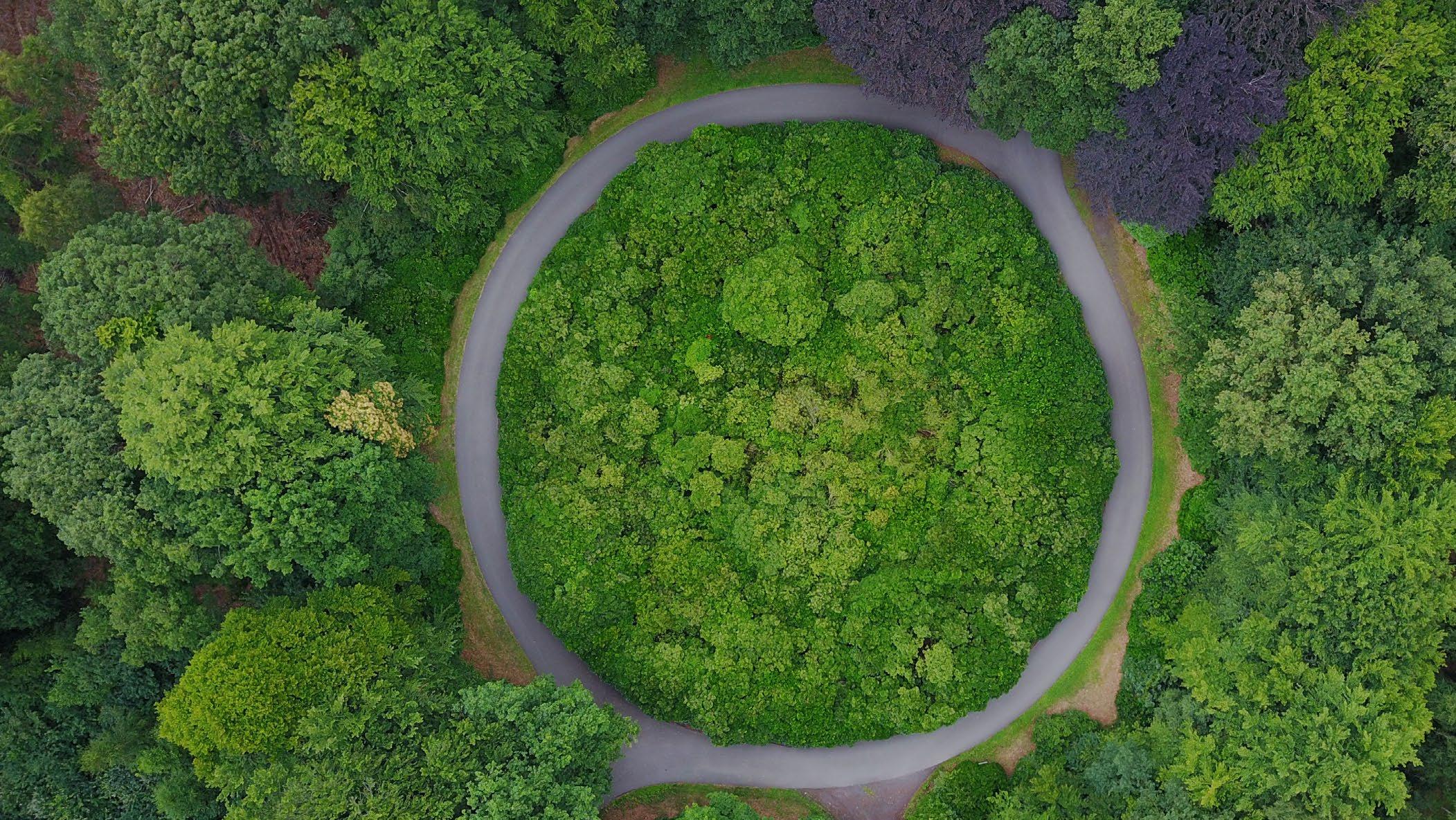
Our new 1.5°C-aligned science-based target is Reduce Scope 1, 2 and 3 GHG emissions 46 per cent by 2030 compared to 2019 and reach Net Zero GHG emissions by 2050. As we continue to define our roadmap, we will begin reporting progress against our new target next year.
UN Race to Zero and Business Ambition for 1.5°C We joined the UN’s Race to Zero campaign to affirm our commitment to reducing emissions across all three scopes in-line with the Paris Agreement, with transparent action plans and robust near-term targets. As a member of Business Ambition for 1.5°C, we are committed to leadership on climate action. Investments
Emissions from holding investments c. 76,000 tonnes CO2e
Consumer disposal
Emissions from disposing of packaging by the consumer c. 800,000 tonnes CO2e
Recycling depots
Emissions from processing material at our depots c. 14,000 tonnes CO2e
Intermediate processing
Emissions from manufacturing paper from waste and boxes from paper that we sell to other paper and packaging producers c. 900,000 tonnes CO2e
Business travel
Emissions from travelling for business purposes c. 4,000 tonnes CO2e
Offices
Emissions from powering our offices c. 4,000 tonnes CO2e Machinery we buy
Emissions from producing the capital goods that we buy c. 87,000 tonnes CO2e
Fuel and energy we buy
Emissions from producing and distributing the fuels and energy we power our business with c. 400,000 tonnes CO2e
Paper mills
Emissions from producing paper at our mills c. 2.4 million tonnes CO2e
Waste we cannot use
Emissions from disposing of waste that we cannot produce packaging from c. 300,000 tonnes CO2e
Packaging plants
Emissions from producing packaging at our plants c. 500,000 tonnes CO2e
Employee commuting
Emissions from employees travelling to and from work c. 8,000 tonnes CO2e
Transportation
Emissions from transporting goods to and from DS Smith c. 500,000 tonnes CO2e
GHG emissions by operation
In 2019/20, our emissions across all three ’scopes’ totalled c. 8.9 million tonnes CO2e. Delivering a 46 per cent reduction by 2030 will result in removing c. 4 million tonnes CO2e across our own operations and our value chain.
Scopes 1 and 2: 2,974,165 tonnes CO2e
Paper: 2,439,146 tonnes CO2e
Packaging: 522,160 tonnes CO2e
Recycling: 12,859 tonnes CO2e
Scope 3: 5,671,528 tonnes CO2e
Total
8,645,693 tonnes CO2e
Now Next Net Zero
Driving carbon reduction with the solutions that exist today Scaling up renewable energy sources in a circular economy Implementing solutions that are still in development today
Building on our c. 29 per cent reduction in emissions per tonne of production since 2015, we continue to...
- Upgrade inefficient assets, such as old boilers - Invest in new combined heat and power plants - Replace fossil fuels with energy from waste - Purchase electricity from renewable sources - Drive energy efficiency improvements The future will depend on securing supply of renewable fuel sources in a low carbon, circular economy...
- Switch from natural gas to low- and zeroemission fuels, such as biogas and biomass - Transition to a circular economy for renewable energy and materials to cut emissions In the long-term, solutions will be needed to drive complete system transformation to eliminate waste, circulate resources and regenerate nature...
- Use biofuels at scale, including green hydrogen - Invest in new technologies such as e-boilers
8.6m

tonnes CO2e
Now and Next targets that reduce life cycle GHG emissions of our packaging solutions: • All packaging recyclable or reusable by 2023 • All strategic suppliers to set science-based targets by 2027
2022 4.8m
tonnes CO2e
Now and Next targets that reduce life cycle GHG emissions of our packaging solutions: • All our packaging to be recycled or reused by 2030 • All our packaging to be optimised for individual supply chains by 2030 • Send zero waste to landfill by 2030
2030 1.7m
tonnes CO2e
2040 Our path to Net Zero
Our path to Net Zero is illustrative, and through continuous review, our internal plans, which contain considerably greater detail, will be re-aligned to take advantage of the best-cost options available at the time considering for example, future costs, technology and commodity availability. High-quality GHG emissions removals, such as technological and natural solutions, will be used to neutralise any limited emissions that cannot be eliminated from 2050 onwards.
2050
Our plan to reach Net Zero
Our 1.5°C-aligned science-based target has been validated by the Science Based Targets initiative (SBTi).
Investing in the future In order to deliver our commitment, we will invest consistently over the next 28 years in our own operations. This includes the adoption of next generation engineering solutions, such as biomethane boiler technology. We will harness self-generated renewable energy sources, such as wind and solar, and power purchasing agreements to accelerate the use of renewable electricity.
Target boundary and reporting We include 100 per cent of our GHG emissions, across all three scopes covering our global operations, within the target boundary, which includes land-related emissions and removals from bioenergy feedstocks. Progress is reported externally at least annually in the DS Smith Annual Report, DS Smith Sustainability Report and to reputable ESG ratings, such as CDP. The 2019/20 base year has been verified to a limited level of independent assurance and assurance for key metrics is obtained (see page 62).
GHG emissions reduction roadmap Supporting the delivery of our science-based target is a roadmap of key strategic projects to reduce GHG emissions. This is aligned with our growth strategy and prioritises the greatest sources of GHG emissions, with site-level project planning and performance management in place.
Assumptions Assumptions made in our plans relate to, for example, discount rates, currency conversion, investment years and technical lifetimes, as well as cost assumptions (e.g. carbon, commodity and offset prices). Forecasts considered the availability of biomass supply, as well as the availability of renewable energy sources to meet the expected energy demands of the business. Fuel options, earliest investment times and future technology solutions have been assumed, in addition to rates of energy efficiency and future product development and growth. Finally, for our supplier engagement target, we assume that c.76 per cent of our emissions covering purchased goods and services are ‘strategic’ suppliers and that these are the suppliers that will be encouraged to set a science-based target by 2027. Challenges and uncertainties There are inevitable challenges and uncertainties relating to our plan, which stem from planning actions far into the future. It is challenging to predict future availability and cost of commodities, as well as the future policy environment. Site space availability, permitting and the impact on site operations, such as increased traffic and site-level production growth, can be difficult to anticipate.
Governance of our plan The substantial strategic decision to adopt a 1.5°C-aligned science-based target was approved by the Board and our Group Operating Committee (GOC) in early 2022. Alongside all of our Now and Next sustainability targets, the Health, Safety, Environment and Sustainability (HSES) Committee, chaired by our Group Chief Executive, oversees the execution of our plan to reach Net Zero, ensuring that the business has adequate access to resources to deliver the commitment. Performance is reviewed by Group and Divisional management on a monthly basis.
Climate-related remuneration Our Now and Next sustainability strategy, including our commitment to reach Net Zero GHG emissions by 2050, helps us to differentiate as a circular economy leader. This drives ongoing profitability and cash flow, which are the current performance measures for our incentive plans. The underlying importance of ESG and sustainability, including our response to climate change, continues to be emphasised by the use of a variety of ESG considerations as an underpin to the annual bonus. In 2021/22, the three elements of the ESG underpin were met, including the commitment to carbon reduction in the business, based on science-based targets. For 2022/23, the Remuneration Committee will continue to take into account and report on, amongst other ESG factors, the development of initial plans to achieve the longer-term science-based targets for carbon reduction in the business. For more information, see DS Smith Annual Report 2022, page 102.
Use of offsets In our initial plan, we aimed to use high-quality offsets only as a last resort to balance a maximum of 15 per cent remaining emissions through high-quality natural climate and technological solutions in 2050. Since developing our initial plan, the Net Zero standard allows only up to 10 per cent of remaining emissions to be offset. As the thinking around standards for Net Zero is still at an early stage, we will monitor these developments closely. Task Force on Climate-related Financial Disclosures (TCFD)

In DS Smith Annual Report 2022, we report on our climate-related risks and opportunities in accordance with the Task Force on Climate-related Financial Disclosures (TCFD) recommendations.
Our plan to reach Net Zero responds to climate-related risks and opportunities, including:
Increasing spend on carbon taxes
Increasing cost of raw materials or threat to supply
Increasing likelihood of water stress Growth in demand for sustainable packaging
Use of emerging renewable technologies
Increasing resource efficiency
See DS Smith Annual Report 2022, p. 56-60 for our complete TCFD disclosure
Measuring and improving biodiversity

H OW DOES THIS ENABLE THE CIRCULAR ECONOMY ? The circular economy is regenerative by design, prioritising resource use in the economy over resource extraction from natural systems. By using the same resources over and over again, natural systems can be left to regenerate and biodiverse ecosystems to thrive.
Why does this matter?
Measuring and improving biodiversity is essential to ensure the survival of plant and animal species, genetic diversity and natural ecosystems. Biodiverse natural ecosystems provide clean water and air, contributing towards resource security and human health.
How does this contribute to the UN SDGs?
Measuring and improving biodiversity contributes to reducing the degradation of natural habitats, halting the loss of biodiversity and protecting and preventing the extinction of threatened species Now
• By 2025, launch 100 biodiversity projects across
Europe and North America • Maintain forest management certification at 100 per cent of our forests
Next
• By 2025, measure and improve biodiversity in our own forests • By 2025, run a biodiversity programme at all of our paper mills Next steps
• Develop an action plan following baseline biodiversity findings for our forests in Georgia, USA • Develop a forward-looking biodiversity roadmap to strengthen our biodiversity commitments and actions • Support the remainder of our paper mills to establish their biodiversity programmes Number of biodiversity projects launched
2021/22 2020/21 57
Number of biodiversity programmes launched
2021/22 2020/21 3
This year, we joined forces with the Warnell School of Forestry and Natural Resources at the University of Georgia in North America to determine a baseline for the biodiversity in our forests in Georgia, USA, which includes identifying a methodology to measure biodiversity across our c. 7,000 hectares of forest in North America. Senior undergraduate students will be identifying the species in our forests through field surveys, ultimately to propose, prioritise and implement actions to improve biodiversity. This is an exciting collaboration that not only intends to lead to biodiversity enhancement, but also offers local students a comprehensive final-year project to apply their learning to a practical, real-world challenge. Over the past few months, students have created an inventory of potential species through a Geographic Information System (GIS) review of all properties, field surveys and laboratory, computer and literature research. The findings and recommendations from this work will form the basis of our plans to measure and improve the biodiversity of the forest, involving future students. We are exploring the possibility of extending learnings from this work in Georgia to our forests in Portugal and Spain.

In over 20 countries, we have launched 100 biodiversity projects (2020/21: 57), meaning that we have achieved our target to launch 100 projects by 2025, three years ahead of plan. Throughout the year, over £187,000 has been given by the DS Smith Charitable Foundation to fund biodiversity projects and programmes, including collaboration with other organisations, such as schools, charities and specialist conservation groups, to amplify our positive impact on biodiversity. Grants of around £1,000 were awarded, with applications approved depending on geographic spread and expected benefits for biodiversity enhancement, protection or education.
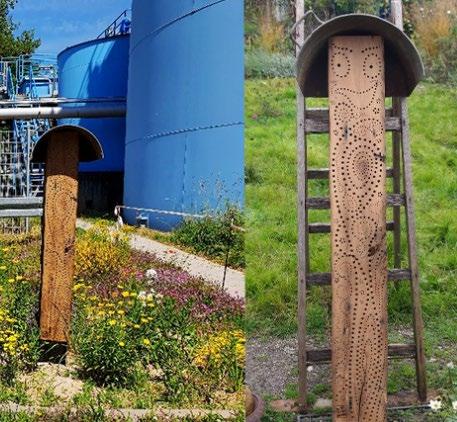
From supporting practical biodiversity projects and lessons with school children in Poland, Croatia, Belgium and Lithuania, to protecting rare and threatened bird species in Austria, rewilding via flower meadows in Switzerland, France and the Czech Republic, and planting fruit trees in Finland, we are pleased that these projects support biodiversity in a myriad of ways.
By 2025, run a biodiversity programme in the local communities of our mills
In 2021/22, 12 (2020/21: three) of our paper mills in total have launched biodiversity programmes, which reflect the implementation of a multi-year biodiversity commitment, comprising a series of projects to support biodiversity on site and in collaboration with their local communities. A further three programmes are in progress. At Aschaffenburg Mill, biodiversity is being enhanced by creating wildflower meadows, introducing a large selection of native plants and shrubs, installing bird nesting boxes, deadwood and stone structures, and a landscaped area for lizards.
Ulrich Albert
MD Aschaffenburg Mill
At Alcolea Mill, the biodiversity programme focuses on protecting the white stork, a bird of local significance and national protection in the National Catalogue of Endangered Species. This has included the installation of two artificial stork nests on poles, six metres high to encourage nesting. Get Nature Positive campaign
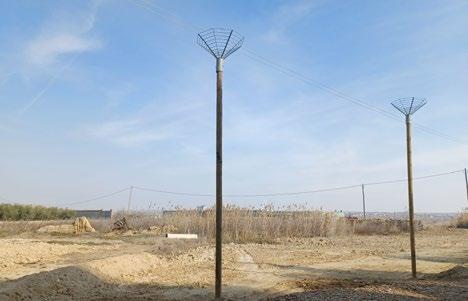
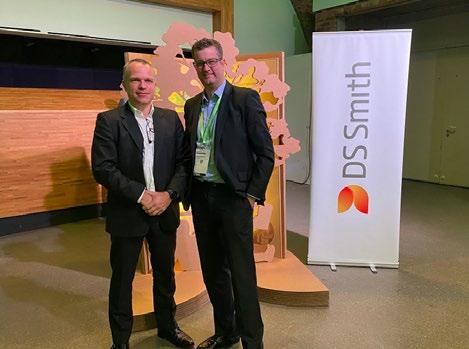
At COP26, attended by our Head of Sustainability, Government and Community Affairs and Director of Corporate Affairs, we announced our membership of the Get Nature Positive campaign, committing to work with more than 70 companies from various industries to help tackle, halt and reverse the loss of biodiversity and to challenge each other to build a nature positive future.
Task Force on Nature-related Financial Disclosures (TNFD) We are monitoring the development of the TNFD with interest, as an important disclosure framework for organisations to report on and act on evolving nature-related risks. Our work to measure and improve biodiversity will help us begin to understand the integrity of the natural ecosystems within our business.
Information and policies
Sustainable Forest Management and Fibre Sourcing Policy CDP Forests response
Managing water responsibly
H OW DOES THIS ENABLE THE CIRCULAR ECONOMY ? The circular economy principles can be applied not only to physical materials, but also to natural resources, including water. We use water as a resource for carrying and transforming fibre through our operations, with over three quarters of the water we withdraw safely returned to the natural environment to continue the water cycle.
Why does this matter?
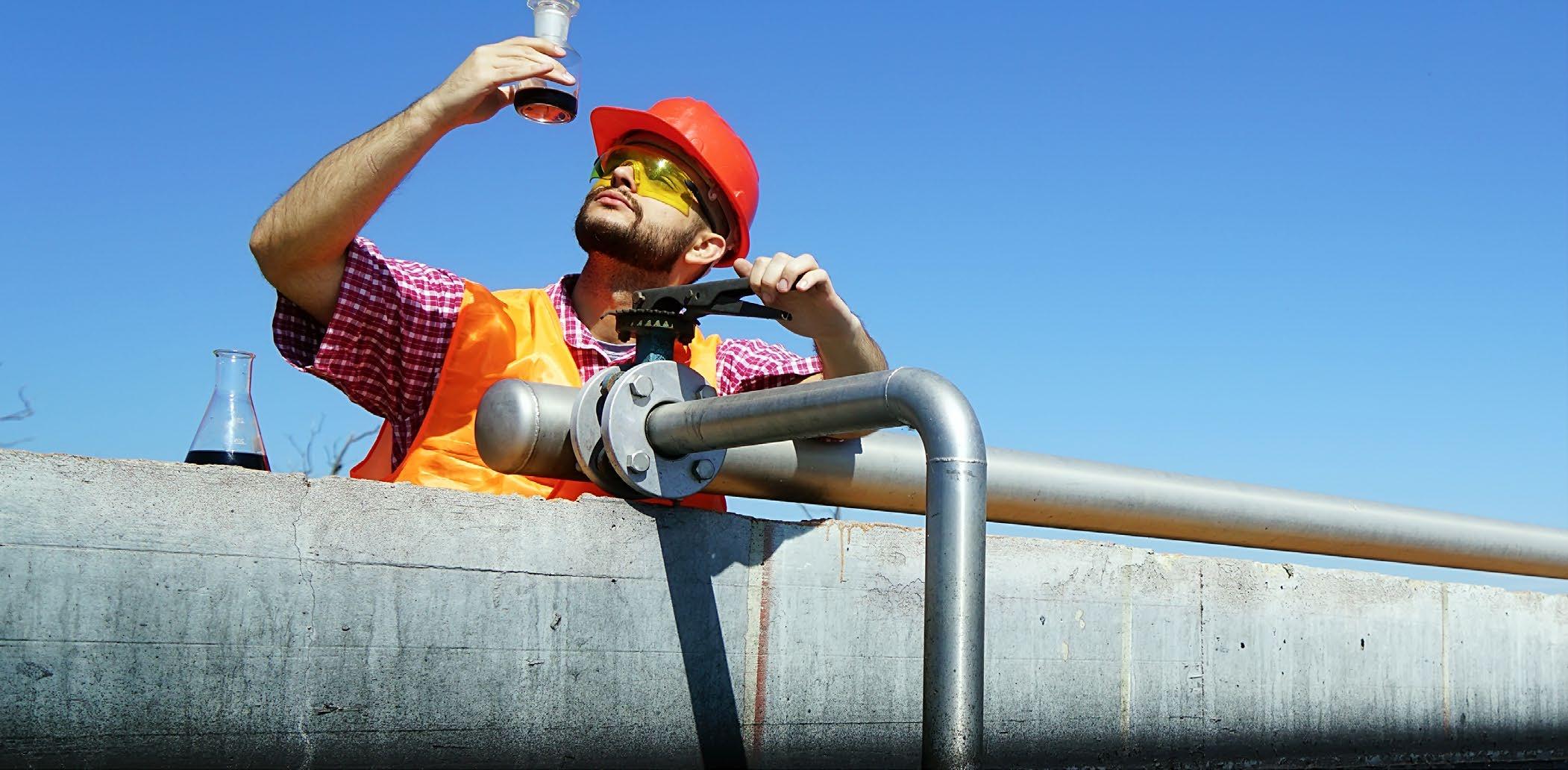
Managing water responsibly is important to benefit and respect the needs and priorities of all water users in a locality, in a way that does not harm the natural ecosystem and water cycle.
How does this contribute to the UN SDGs?
Managing water responsibly contributes to improving water quality, efficiency and scarcity, protecting and restoring water ecosystems. Now
• By 2025, achieve zero non-conformances with consents to discharge • Maintain a water stress mitigation plan at 100 per cent of our sites in areas at risk of water stress
Next
• By 2030, reduce water withdrawal by 1 per cent per tonne of production per year at mills in areas at risk of water stress compared to 2019 Next steps
• Implement our new minimum standard for water effluent management to increase effective operation of waste water treatment plants • Develop near-term projects to decrease water withdrawal at targeted sites within our roadmap • Continue to maintain water stress mitigation plans at 100 per cent of our sites in areas at risk of water stress Water withdrawal at paper mills in current or future water stressed areas (m3/t nsp)
2021/22 2020/21 2019/20 8.08 8.10 8.48
2021/22 2020/21 2019/20 10
21
In 2021/22, 10 notifications of non-conformance with consents to discharge were received (2020/21: 21), a reduction achieved through stronger water management practices. This includes effective compliance monitoring of volumes, flow rates, discharge contents and proactive maintenance and calibration of equipment. A significant challenge continues relating to inks containing high levels of copper. Some progress has been made in customer acceptance of alternative ’copper-light’ inks, which reduce the demand on waste water treatment plants. A Group minimum standard for effluent management was developed with plans to implement during 2022/23. The standard sets out requirements to ensure compliant operation of waste water treatment plants and decreasing instances of non-conformance.
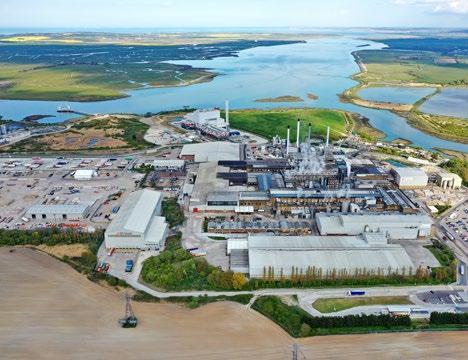
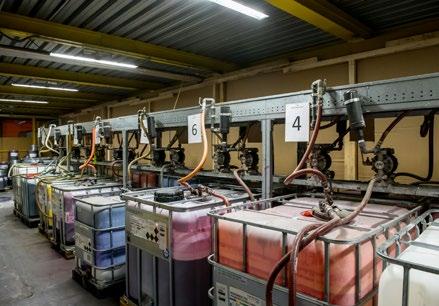
Case study Circular economy for leftover ink
At all of our Packaging sites in France, we have applied circular economy thinking to recover and mix leftover inks. As an alternative to discharging leftover ink and instead of buying black ink, our leftover ink becomes a resource by combining inks of various pigments to create a technical black ink for labelling and trademarks. By reusing the leftover inks, we reduce pollutants in our wastewater discharge, particularly the level of metals, which reduces instances of non-conformance and lessens the likelihood of water pollution. Following the success of this for improving wastewater discharge quality, we are exploring application in other regions. By 2030, reduce water withdrawal by 1 per cent per tonne of production per year at mills in regions at areas of water stress compared to 2019
During the year, we set a new Now and Next sustainability target to decrease water withdrawal 1 per cent per tonne of production per year, every year, to 2030 compared to 2019 at our paper mills located in regions at high or extremely high risk of water stress by 2030. This was achieved for 2021/22, operating at 8.08 m3/t nsp (2020/21: 8.10 m3/t nsp), which is a 5 per cent decrease compared to the base year (2019/20: 8.48 m3/t nsp), demonstrating progress ahead of target. At Pazardzhik Mill, a new water recirculation system has been installed, which has reduced water withdrawal by c. 23 per cent compared to 2019/20. This has been made possible due to installation of a three-stage grid filter within the effluent system to remove contaminants so that recovered water can easily flow back into the process, which now recirculates around 12m3 of water per tonne of production.
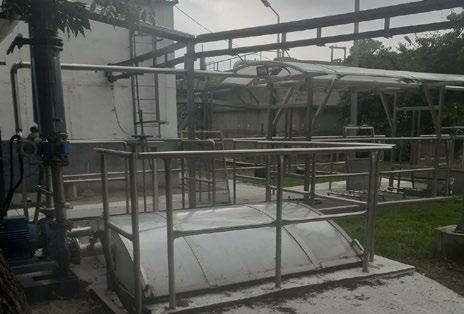
Progress towards this target lessens pressure on natural water resources through water reduction, reuse and recycle opportunities, protecting water as a finite natural resource. Maintain a water stress mitigation plan at 100 per cent of our sites in regions at risk of water stress
At the beginning of 2021/22, we re-ran our annual WRI Aqueduct assessment of water stress risk to ensure maintenance of water stress mitigation plans at 100 per cent of sites at current or future risk of water stress. This process builds water stress risk mitigation into business continuity planning, requiring regular contact with relevant stakeholders (e.g. the water authority and local community) and reviewing water performance regularly. We continued to evolve our climate scenario analysis for the Task Force on Climate-related Financial Disclosures (TCFD), which incorporates water stress as a long-term climate-related risk. Our exposure to water stress decreased significantly this year, with the worst-case IPCC RCP 8.5°C scenario suggesting that c. 31 per cent (2020/21: c. 36 per cent) of the Group’s total water withdrawal is in regions at risk of water stress, having removed our non-core Dutch paper mill from the analysis, following its disposal during the reporting period. We continue to reduce water withdrawal and therefore lessen our exposure to water stress risk.
CDP Water Security A-List
Our 2021 CDP Water Security response secured a place on the prestigious ’A List’ for tackling water security, with an ’A’ score for global water stewardship, joining a small number of high-performing companies demonstrating significant action to protect water resources.
Information and policies
Water Stewardship Policy WRI Aqueduct Water Risk Atlas CDP Water Security
Sending zero waste to landfill

H OW DOES THIS ENABLE THE CIRCULAR ECONOMY ? The circular economy finds beneficial uses for all materials, including the waste that enters our circular business mixed in with used paper and cardboard. Diverting waste from landfill to alternative destinations means that waste is treated as a resource and an opportunity from which to extract value.
Why does this matter?
Sending zero waste to landfill reduces the impacts of landfill waste, which include effects on the climate, impacting ecosystems and wildlife, as well as human health and well-being.
How does this contribute to the UN SDGs?
Sending zero waste to landfill contributes to substantially reducing waste generation through prevention, reduction, recycling and reuse. Now and Next
• By 2030, send zero waste to landfill
Next steps
• Ensure successful start-up of our near-term projects to divert waste from landfill • Continue to apply circular economy principles in our own operations to find productive uses for the non-fibre rejects that enter our circular business • Continue to advocate for source-segregated, clean waste streams to lessen the volumes of non-fibre rejects that go to landfill Total waste sent to land ll (tonnes)
2021/22 2020/21 2019/20 255,920 258,225
By 2030, send zero waste to landfill
In an ideal world, only fibre would enter our circular business, but the reality is that through our recycling operations, non-fibre materials enter our business through poor quality waste streams. These must be removed before papermaking can begin and we continue to reduce waste to landfill with beneficial alternative waste destinations. In 2021/22, 255,920 tonnes of waste was sent to landfill (2020/21: 258,225). In total, 93 per cent of waste landfilled was landfilled by our Paper division, whilst our Packaging division maintained a 99 per cent landfill diversion rate. Across the Group, 63 per cent of waste was recycled, 11 per cent was used for landspread, 9 per cent was incinerated and 17 per cent was landfilled. Although progress was made on landfill reduction at some of our sites (c. 12,000 tonnes less compared to 2020/21), increases at other sites for various operational reasons, including increased volumes, have masked this good performance. Furthermore, anticipated reductions were not made this year owing to delays to the expected start-up of some projects. We remain confident in our pipeline of landfill reduction projects.
Landfill reduction projects at our paper mills
At Kemsley Mill, c. 8,000 tonnes of landfill waste will be diverted annually by sending waste previously landfilled to the neighbouring K3 waste-to-energy facility, which has begun to start-up this year. As well as reducing waste to landfill, this facility also produces steam for the mill by generating energy from the waste. At Alcolea Mill and Belisce Mill, landspread and sludge opportunities are set to divert c. 9,000 tonnes per year and at Dueñas Mill, an alternative use has been identified for c. 11,000 tonnes annually. Aschaffenburg Mill and Witzenhausen Mill each maintained zero waste to landfill and Coullons Mill and Kaysersberg Mill each achieved zero waste to landfill during the year. A life beyond landfill at our recycling depots
Our UK recycling depots have sent zero waste to landfill since the beginning of 2022. Although we have taken in some non-fibre material, we have been able to find a recycling opportunity for every tonne of waste.
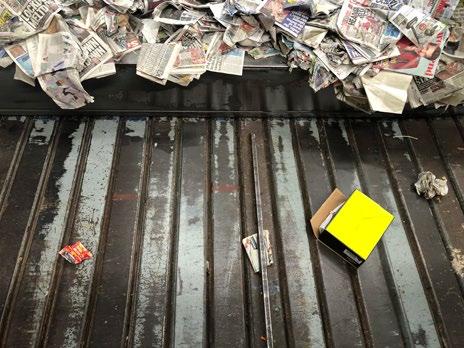
“Our recycling depots have made huge strides in reducing waste to landfill. We have set the challenge to them that we are the Recycling division, not the ‘waste division’, and we should be setting the example. The zero waste to landfill achievement of our UK depots is the most notable, but other countries and depots have made huge improvements too. Our focus over the coming years is to reduce this to zero across all depots ahead of the 2030 target deadline.”
Jonathan Edmunds
Recyclability and Sustainability Manager
In Spain and Portugal, waste to landfill has reduced by c. 50 per cent compared to last year and several smaller depots have achieved zero waste to landfill, including Babberich (Benelux), Turin and Casarille (Italy). Digital and data for improving the quality of paper and cardboard collected for recycling
We have begun to use an AI tool in collaboration with IBM to help to improve the quality of paper and cardboard collected for recycling.
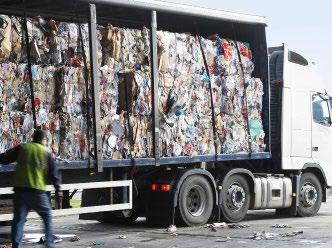
Trialling the technology at our recycling depot in Kemsley, we have invested in new camera technology that uses AI modelling capabilities on IBM Cloud, to assess the grade, quality and origin of the material arriving at the depot. Positioned in the ceiling of the depot, the cameras can identify whether the composition of the loose paper and cardboard meets strict quality guidelines before being sent for baling and recycling. This was achieved by teams from DS Smith and IBM Expert Labs working together to develop an AI model that can compare data from images of the materials with a specific set of criteria. The state-of-the-art innovation improves the efficiency and accuracy of the process, which has traditionally been done using the human eye. The insights drawn from the imagery are used to inform the production process but can also be reported back to suppliers to help improve the quality of the material arriving at the depot. This technology can help us on our journey to zero waste to landfill, as better-quality material entering the papermaking process results in fewer rejects that are sent to landfill. Landfill reduction projects at our packaging plants
Decreases in waste sent to landfill were achieved throughout the year through, amongst other things, upgrades to waste water treatment plants and engagement initiatives. For example, a new waste management programme was implemented at our Vineland packaging plant in North America. This began with identification of the various waste streams throughout the facility, capturing data relating to weights of all waste. The team implemented colour-coded signs to encourage recycling. Recognised as a model example by our third-party waste auditor, the site reduced the waste it sends to landfill by more than half compared to last year.
Roadmaps for delivering further progress
In 2021/22, the Paper division continued to develop its roadmap towards achieving zero waste to landfill by 2030, with key projects and milestones in place. As these projects often have carbon, energy and water implications, this roadmap is developed and managed alongside other roadmaps, including our plans to reach Net Zero GHG emissions, for which waste-to-energy plays a role. During the year, the Recycling division created a roadmap running up to 2030 and in 2022/23, roadmaps will be developed for our Packaging division.
Reducing Scope 3 greenhouse gas emissions Sending less waste to landfill has the added benefit of reducing the emissions generated by landfill waste as it decomposes, which is captured in our Scope 3 inventory. As we make progress on our zero waste to landfill target, our Scope 3 emissions will reduce as alternative waste destinations, such as recycling, release fewer greenhouse gas emissions into the atmosphere compared to waste left in a landfill.
Information and policies
Zero Waste to Landfill Policy







